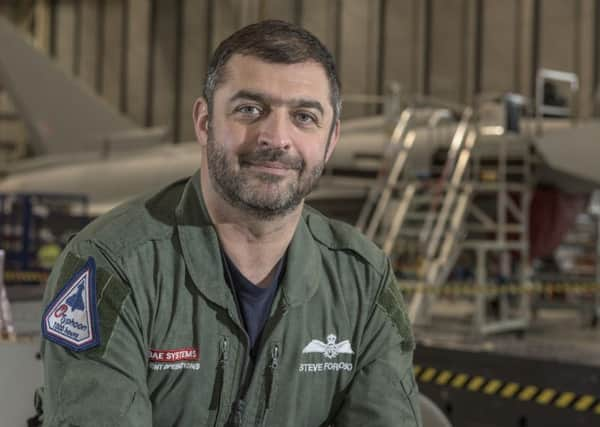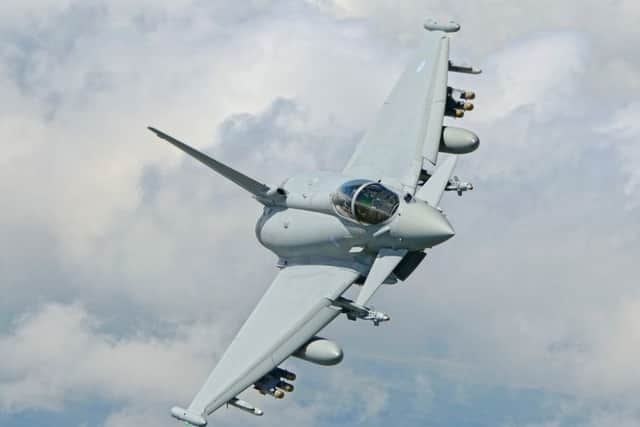When I take to the sky, I still can't believe it's my job


“It is truly gobsmacking to fly. On the production test flights where we take the performance of the aircraft to the max, I still have those moments where I’m saying to myself, ‘I can’t believe I have this job…’
Chief Fast Jet Test Pilot. It’s up there with pop star or rocket scientist as one of the coolest jobs on the planet.
Advertisement
Hide AdAdvertisement
Hide AdIt’s associated with the glamour of air show displays and daring record-breaking feats like those carried out by Chuck Yeager in the 1940s, 50s and 60s. The early US astronauts all came from test flying backgrounds. And for Steve Formoso, Chief Test Pilot based at BAE Systems’ Warton site in Lancashire, the job is more exciting than most.


For a large part of his role involves working with the Eurofighter Typhoon – the most advanced multi-role aircraft on the market, and a platform subject to continual upgrades to its capabilities.
Steve was appointed Chief Test Pilot at BAE Systems in 2015. His CV is impressive.
It combines expert flying abilities, engineering knowledge, communication skills, a good contacts book and a dash of diplomacy.
Advertisement
Hide AdAdvertisement
Hide Ad“There are probably some myths about the job,” says Steve. “For example, the sort of stick-and-rudder flying that Yeager and his ilk had to do where they were fighting with the controls is not really where it is in 2016.


“Today the job is all about offering the right amount of knowledge at the right time into the programme. You use your experience of how the aircraft is used and make sure it influences the product at the right time.”
So what skills do you need to be a test pilot?
Steve says: “Communication is key to most jobs and this is no exception. As a test pilot you have to be able to say there’s something not right about the design.
“When you operate with the aircraft you find things that need changing and understand why they need changing. It’s a bit of an art form and that’s what you are trained to do as a test pilot. You are often the only person in the company who will see an issue because there are only five of us actually flying the product.
Advertisement
Hide AdAdvertisement
Hide Ad“It’s a privileged and important position and that’s why communication is crucial.
“Test pilots are designed to look for flaws in products but you have to communicate it.”
Steve’s introduction to flying came when he was an eight-year-old, when his mum and dad took him out for a day trip and, quite by chance, they decided to go for a glider trip at an airfield near Oxford.
“I remember that day vividly,” he says.
“And I still have an old Polaroid my dad took. I was hooked from that moment on. I knew what I wanted to do. It seemed to me to be the most natural thing in the world to decide.”
Advertisement
Hide AdAdvertisement
Hide AdHe joined the air side of the cadet force as soon as he was old enough and took a flying scholarship while still at school. Then it was time for university.
“When I was considering my options I weighed up whether the university had an air squadron and somewhere I could hang glide.
“As far as career paths were concerned, my top three were air force, commercial flying and, if all else fails, messing about with hang gliders.”
He ended up going to Swansea University because it ticked all his boxes and, not surprisingly, joined the RAF immediately after graduation in August 1990.
Advertisement
Hide AdAdvertisement
Hide AdThen during his RAF training he volunteered for the Euro NATO Joint Jet Pilot Training Scheme and went to the United States to carry out his primary flying.
His formative military flying career took place at Shepherd Air Force Base in Texas on T37s and T38s, amid young pilots from the United States, Germany, the Netherlands, Denmark and Turkey.
It was in this melting pot that he got his wings.
After graduating in 1992 he went on to fly Jaguars on operational duty with 54 Squadron.
That introduction to life as a frontline pilot was perfect preparation for a busy few years, which included operations in northern Iraq working out of Turkey.
Advertisement
Hide AdAdvertisement
Hide AdThen one day in 2001 he got a call out of the blue asking if he wanted to go to the United States to fly Strike Eagles with the US Air Force as part of an exchange. He started the course flying F15Es and then linked up with the 336th Fighter Squadron, the Rocketeers. When that chapter ended, Steve returned to the UK to face a different kind of challenge. As a staff officer with 1 Group he was asked to look at Typhoon operations at a time when the aircraft was being readied to go into service with the RAF.
His role as Flight Commander on the Typhoon Conversion Unit meant day-to-day flying on the aircraft, as well as working closely with pilots from the RAF and other forces. It was also his first exposure to BAE Systems.
He was then offered a place at the Empire Test Pilot School and, after graduating, went back to RAF Coningsby, but this time as a test pilot with 17 Squadron.
“I came to test piloting relatively late but part of test piloting is the amount of experience you bring to the job. You can’t walk into it as your first job; it would be impossible and you’d have no credibility.”